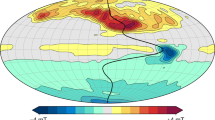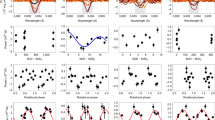Abstract
WHEN the magnetic field of a planet is due to hydromagnetic dynamo action in an electrically conducting fluid core surrounded by a poorly conducting mantle, Hide's1 method can, in principle, be used to determine the radius rc of the core from determinations of secular changes in the magnetic field B in the accessible region above the surface of the planet, mean radius rs rs (⩾rc). It will be possible to apply this method to Jupiter (and other planets) when magnetic measurements of sufficient accuracy and detail become available. We describe here a preliminary study in which we have analysed the magnetic measurements made in December 1973 and December 1974 when the Pioneer 10 and Pioneer 11 fly-by space-probes encountered Jupiter2. We expected that over such a short time interval any true secular changes would be masked by errors and the corresponding estimate of rc/rs highly implausible or even physically impossible, but this turns out not to be the case. Taken at their face value the apparent secular changes in the dipole and quadrupole components of Jupiter's magnetic field imply that rc/rs is close to 0.7. Somewhat higher values of rc/rs are found when contributions from the octupole component are also included.
This is a preview of subscription content, access via your institution
Access options
Subscribe to this journal
Receive 51 print issues and online access
$199.00 per year
only $3.90 per issue
Buy this article
- Purchase on Springer Link
- Instant access to full article PDF
Prices may be subject to local taxes which are calculated during checkout
Similar content being viewed by others
References
Hide, R. Nature 271, 640–641 (1978).
Gehrels, T. (ed.) Jupiter: Studies of Interior, Atmosphere, Magnetosphere and Satellites (University of Arizona, Tucson, 1976).
Hawke, P. S. et al. Phys. Rev. Lett. 41, 994 (1978).
Smoluchowski, R. Phys. Earth planet. Int. (in the press).
Hide, R. in Magnetism and the Cosmos (eds Hindmarsh, W. R., Lowes, F. J., Roberts, P. H. & Runcorn, S. K.) 378–393 (Oliver and Boyd, Edinburgh, 1965).
Hide, R. Geophys. Astrophys. Fluid Dyn. 12, 171–176 (1979).
Hide, R. & Malin, S. R. C. (in preparation).
Elphic, R. C. & Russell, C. T. Geophys. Res. Lett. 5, 211–214 (1978).
Author information
Authors and Affiliations
Rights and permissions
About this article
Cite this article
HIDE, R., MALIN, S. The size of Jupiter's electrically conducting fluid core. Nature 280, 42–43 (1979). https://doi.org/10.1038/280042a0
Received:
Accepted:
Issue Date:
DOI: https://doi.org/10.1038/280042a0
This article is cited by
-
The Juno Magnetic Field Investigation
Space Science Reviews (2017)
-
The interiors of the giant planets ? 1983
The Moon and the Planets (1983)
-
Jovimagnetic secular variation
Nature (1982)
Comments
By submitting a comment you agree to abide by our Terms and Community Guidelines. If you find something abusive or that does not comply with our terms or guidelines please flag it as inappropriate.



